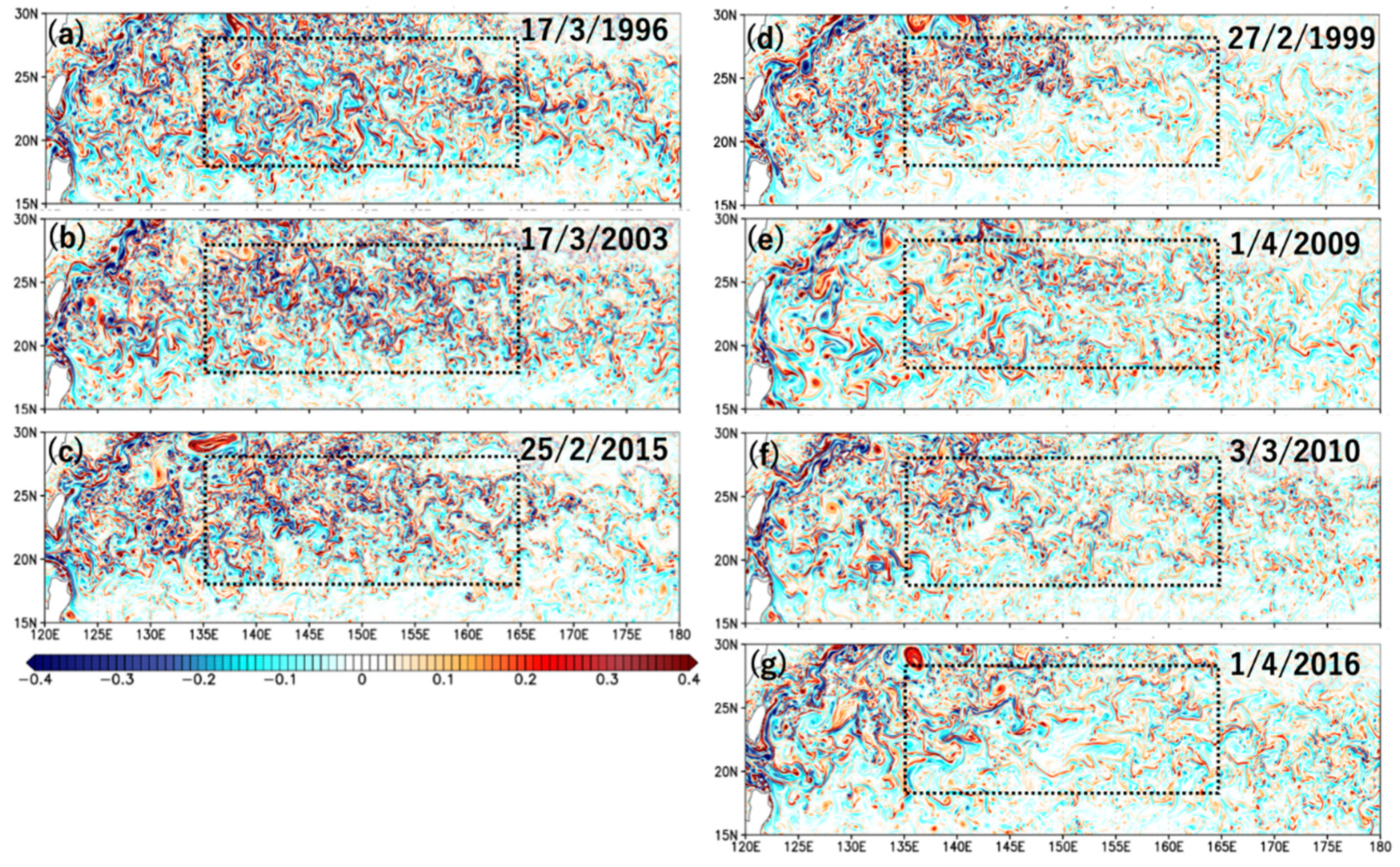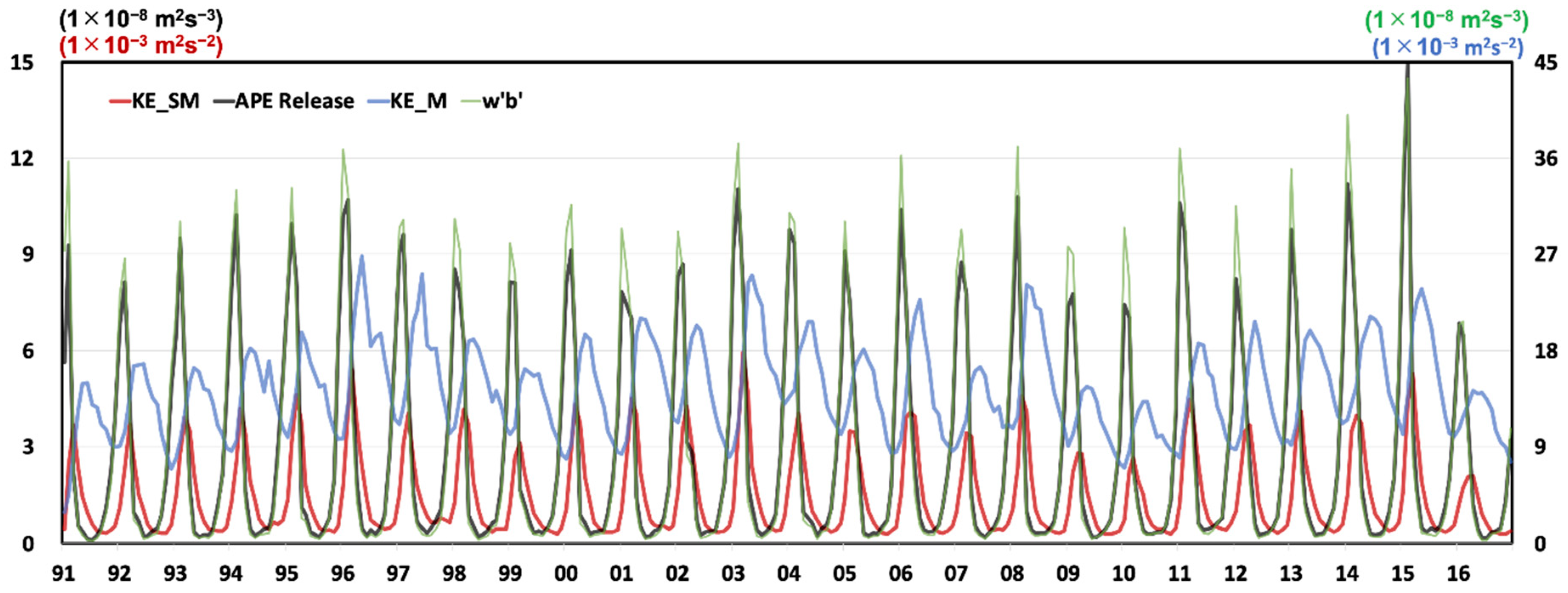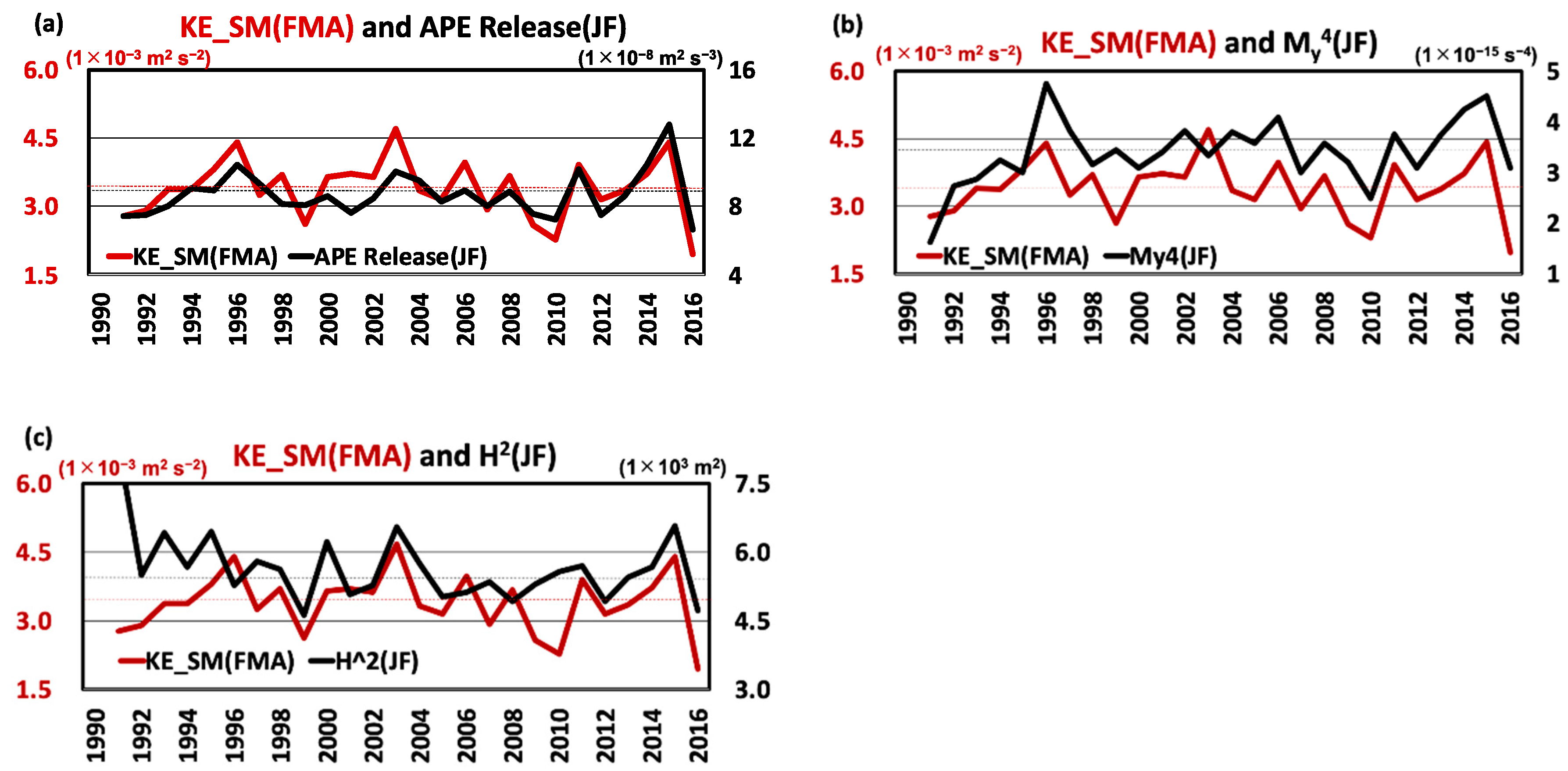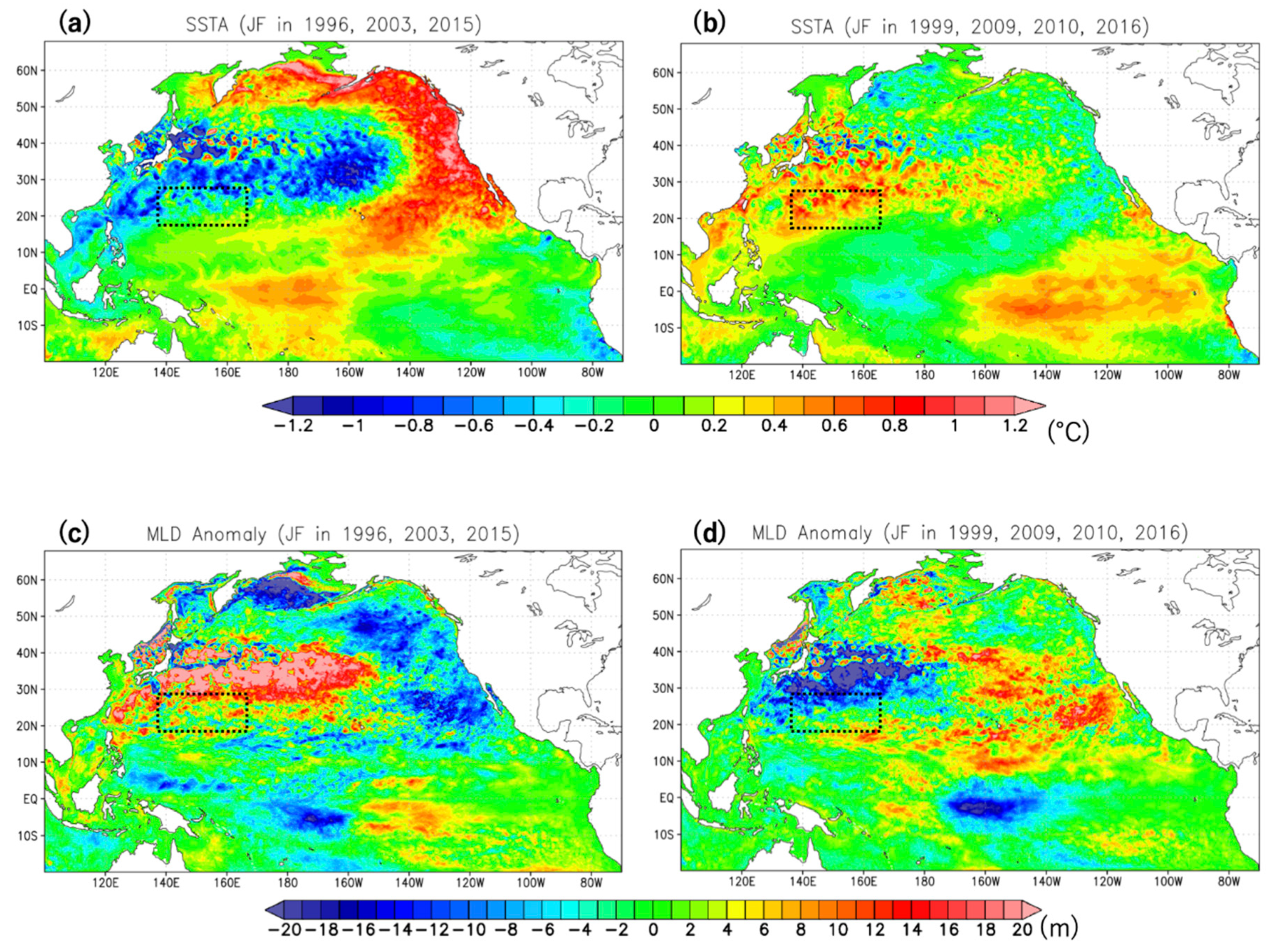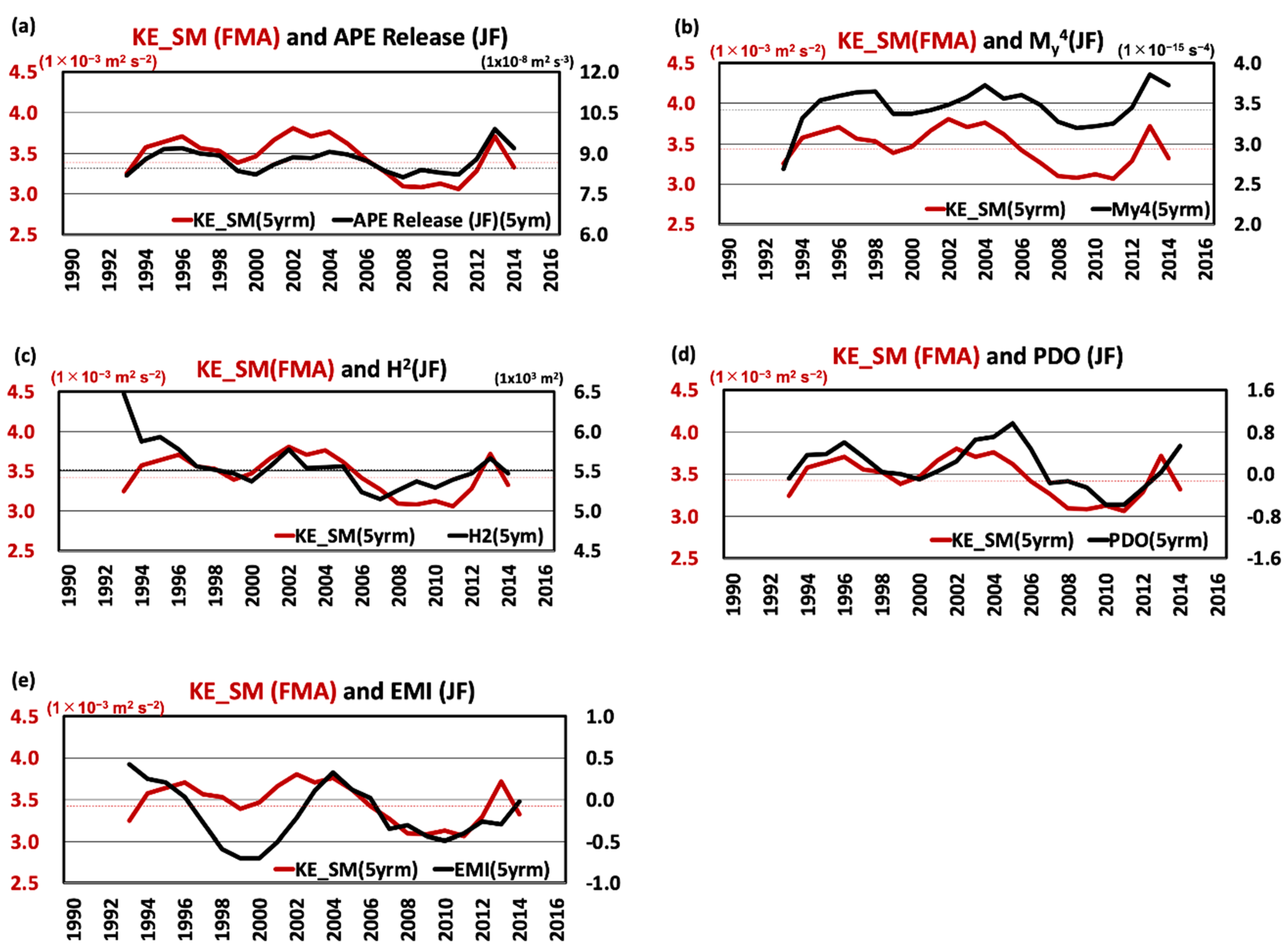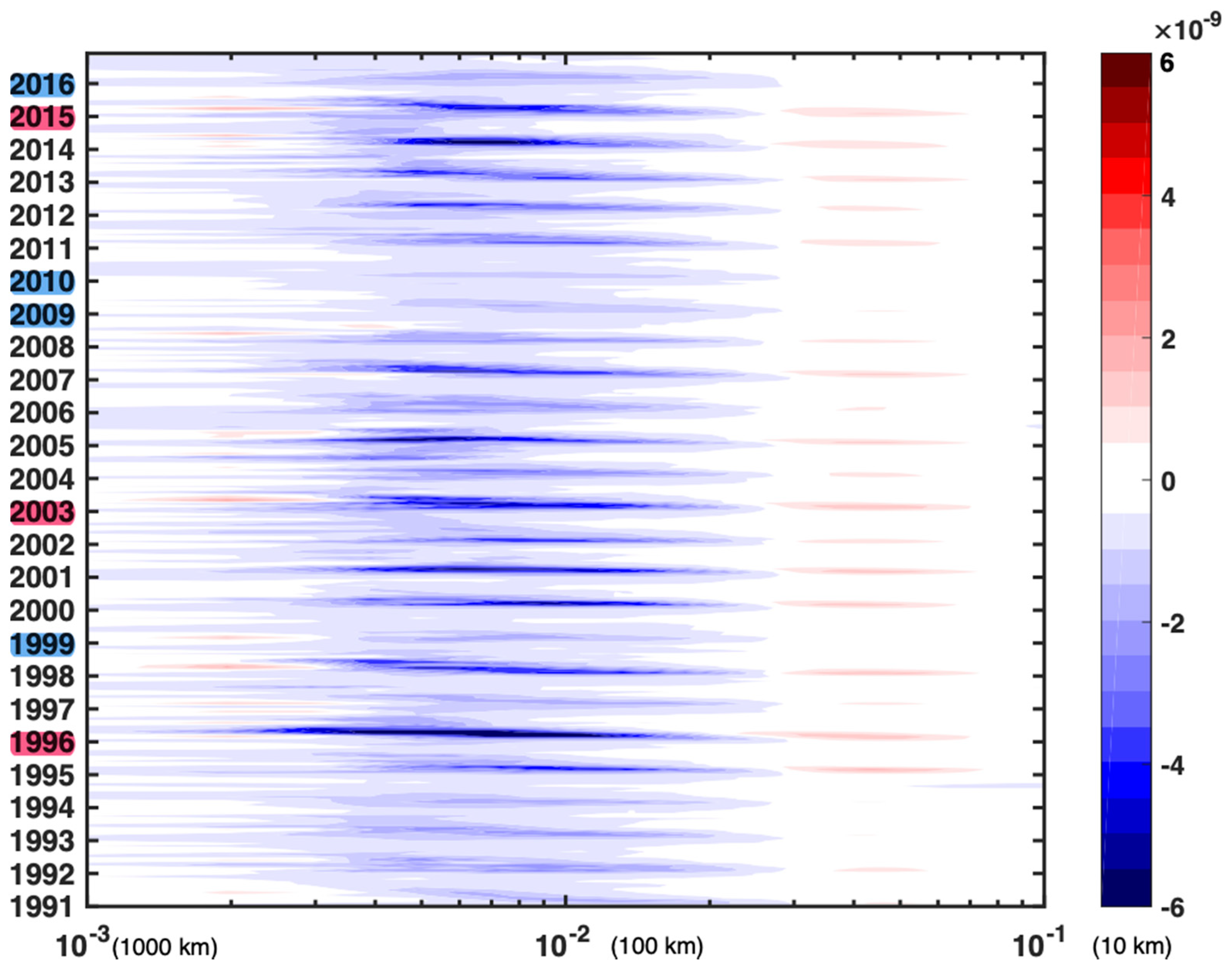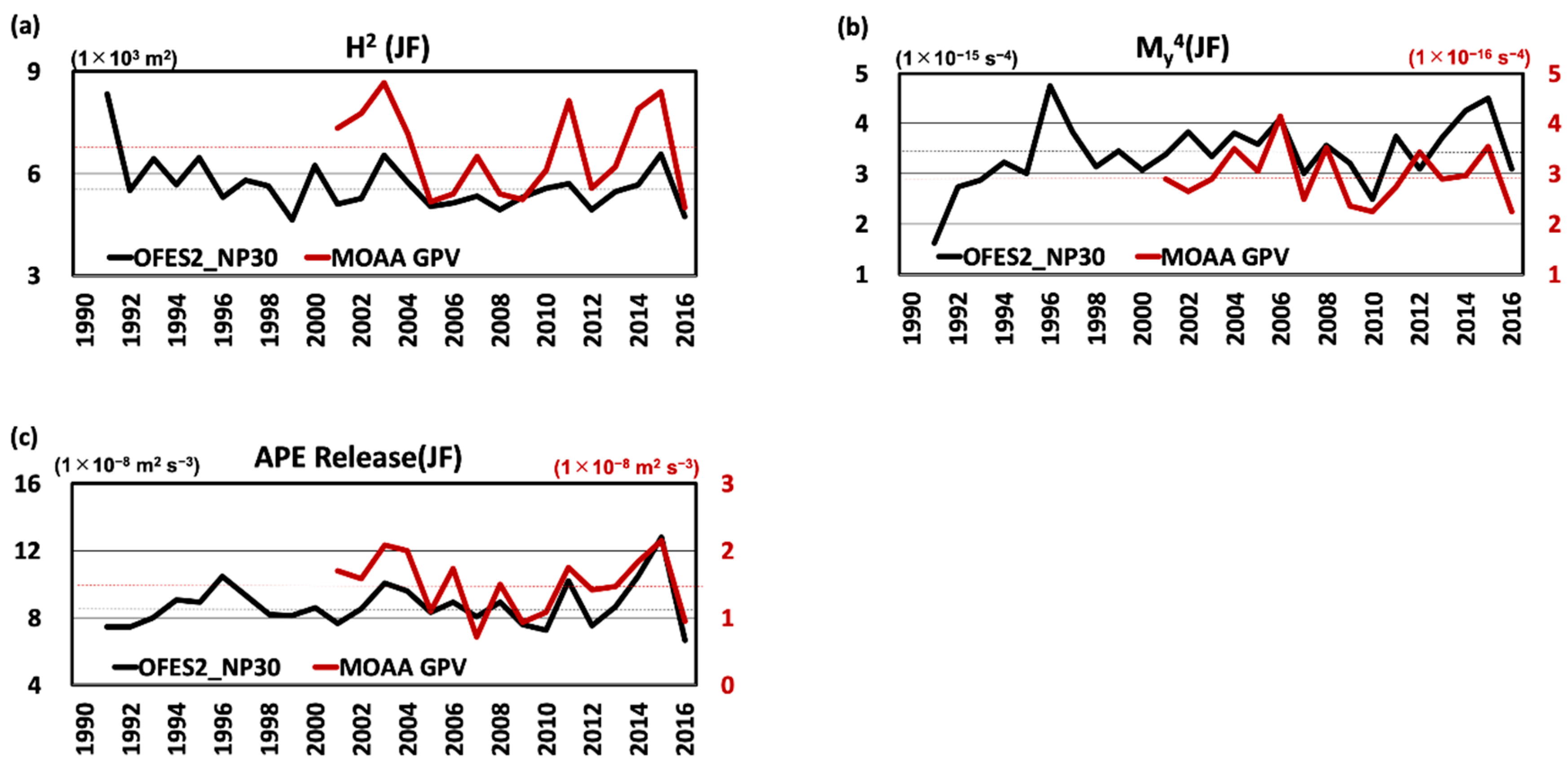3.1. Eddy Kinetic Energy in OFES2_NP30 and Satellite Observation
Before examining the submesoscale motions, the EKE in OFES2_NP30 is compared to the satellite observations from AVISO (
https://www.aviso.altimetry.fr). The EKE is estimated geostrophically from the sea surface height (SSH) anomalies at the horizontal resolutions of 1/30° for OFES2_NP30 and 0.25° for AVISO respectively. The long-term mean EKE distributions in the North Pacific in OFES2_NP30 (
Figure 1a) resemble those in the satellite observations (
Figure 1b). The large EKE (>100 cm
2/s
2) extends from the Western Pacific to the east along the Kuroshio Extension along about 35° N, the STCC along about 22° N, and the HLCC along about 20° N to the west of the Hawaiian Islands. The high EKE along the Kuroshio Extension near Japan is slightly larger in the OFES2_NP30 than the observations. In most regions including the STCC region other than near the Kuroshio Extension, the EKE magnitudes in OFES2_NP30 are a bit smaller than the observations.
In this study, we focus on the STCC region from 135° E to 165° E between 18° N and 28° N (box region in
Figure 1). The low-passed variations of the observation EKE (thin red curve in
Figure 2) show high EKE in 1993–1998 with a peak in 1996 and low EKE in 1999. It gradually increased in 2000–2003 and became high in 2003–2006. In 2007–2010 it gradually decreased and became a minimum in 2010. In 2011–2016, it was relatively high. These variations are broadly similar to those shown by Qiu and Chen (2013) [
14]: high in 1995–1998, and 2003–2006 and low in 1999–2002 and 2009–2011. OFES2_NP30 also captures well these decadal variations (thin black curve), although the mean EKE (187 cm
2 s
−2) is relatively small compared to the observations (257 cm
2 s
−2). This discrepancy may come from the estimation method of surface momentum flux considering the surface current in OFES2_NP30 as previous studies suggest [
23,
24]. In addition to the decadal variations, the EKE was anomalously high in 1996 and low in 1999, 2009, and 2010 in both OFES2_NP30 (thick black curve) and the observations (thick red curve), revealing the EKE interannual variations in the STCC region. Note that the EKE in OFES2_NP30 peaks earlier by about 1.5 months than the observations. This time lag is probably attributed to the different resolutions between the datasets as shown by Qiu et al. (2014) [
4]. OFES2_NP30 at a horizontal resolution of 1/30° simulates well the submesoscale motions whose KE peaks in late winter. On the other hand, the satellite observations at a horizontal resolution of 0.25° capture the motions at scales larger than mesoscale, whose EKE peaks in spring to early summer. These results show that OFES2_NP30 represents well the interannual to decadal EKE variations in the STCC region, although a few discrepancies exist as shown above. In the later subsections, the interannual to decadal variations of the submesoscale motions in the STCC region are examined by using the outputs from OFES2_NP30.
3.2. Interannual Variations of Submesoscale Motions in the STCC Region
The daily mean surface relative vorticity on a winter day in 1996 (
Figure 3a) in OFES2_NP30 shows that submesoscale motions of small eddies and elongated filamentary features are ubiquitous in the Northwestern Pacific regions around the STCC. These small features are prominent along the southern (21° N) and northern (25° N) STCCs. We examine interannual to decadal variability of the active submesoscale motions in winter accompanied by the STCC.
Figure 4 shows daily mean time series of the root mean square (RMS) surface relative vorticity averaged in the STCC region (black curve). The RMS vorticity varies seasonally: large in winter (February and March), which is consistent with the seasonality of the submesoscale EKE in the STCC region revealed by Qiu et al. (2014) [
4]. In addition, the RMS vorticity peak in winter varied interannually: anomalously large in 1996, 2003, and 2015 and small in 1999, 2009, 2010, and 2016. The distributions of surface relative vorticity in the day with the maximum RMS vorticity in each year also display these interannual variations: ubiquitous/active and calm submesoscale motions in these years, respectively (cf. left versus right panels in
Figure 3).
In this study, the surface submesoscale KE with wavelengths shorter than 100 km (KE_SM) averaged in the STCC region is examined to diagnose the variability of submesoscale motions. The time series of daily mean submesoscale KE (red curve in
Figure 4) displays the distinct seasonality, which is more apparent than the RMS relative vorticity (black curve). The submesoscale KE (red curve) is very small from late summer to autumn (~3 × 10
−4 m
2 s
−2), increases rapidly in winter and peaks in late winter (>2 × 10
−3 m
2 s
−2).
The winter submesoscale KE also varied on the interannual time scales (KE_SM, red curve), similar to the RMS relative vorticity (black curve): large in 1996, 2003, and 2015 and small in 1999, 2009, 2010, and 2016. To reveal how the winter submesoscale KE vary interannually, the process of MLI enhancing the submesoscale KE is considered. The baroclinic instabilities develop at the submesoscale within the mixed layer, which enhances the submesoscale KE and leads to the restratification within the upper ocean. Fox-Kemper et al. (2008) [
7] parameterized the MLI considering an overturning streamfunction whose isopycnal surface tilts from the vertical to the horizontal. They proposed that the available potential energy (APE) release in the process of MLI is proportional to the product of the front-averaged horizontal buoyancy gradient (M
2) squared, the mixed layer depth (MLD, H) squared, and the inertial period (1/
f,
f is the Coriolis parameter),
where C is a ratio of eddy flux slope to isopycnal slope (see detail in Fox-Kemper et al. 2008 [
7]).
In this study, the value of C is 2: a typical value suggested by a previous study [
7]. The surface meridional buoyancy gradient (M
y2) is used instead of M
2 because the horizontal buoyancy gradient is mostly in the meridional direction in the STCC region (not shown) and buoyancy does not change much within the mixed layer. Thus, the APE release (−ΔAPE/Δt) becomes
We will examine the right-hand side (=0.5 My4H2/|f|) as the APE release.
The monthly time series of the parameterized APE release in the STCC region (black curve in
Figure 5) synchronously varies with the APE release directly estimated from OFES2_NP30 outputs (w’b’, green curve in
Figure 5, where w and b are vertical motion and buoyancy and the prime denotes the deviation from the local area mean of 10° × 10° subdomain). This synchronization suggests that the estimation of the parameterized APE release (Equation (2)) is qualitatively reasonable. Its magnitude however is about one third of the direct estimation, which suggests that it partially explains the amount of APE release. One possible reason of its small magnitude is the buoyancy gradient only in the meridional direction. Moreover, the mechanisms inducing the submesoscale motions other than MLI should be the candidates (see detail in
Section 4). In the present study, the parameterized APE release (Equation (2)) is used based on the synchronization with the direct estimation.
The APE release varies seasonally (black curve in
Figure 5): peaks in winter and bottoms in late summer and autumn. The peaks and bottoms of submesoscale KE (red curve) follow those of the APE release with one or two months lag. This time lag can be explained by energy budget of submesoscale motions: the submesoscale KE increases via the APE release and decreases via KE cascades to the other scales. In addition to the seasonality, the peaks of the submesoscale KE and APE release in winter appear to vary synchronously on the interannual time scales. To show these interannual variations more clearly, the annual time series of the submesoscale KE averaged from February to April (red curve) and the APE release averaged from January to February (black curve) were made (
Figure 6a). Both time series vary synchronously and the correlation between them is high (0.77). These results suggest that the interannual variations of the APE release in the process of the MLI lead to the submesoscale KE variations in the STCC region.
The APE release depends on the APE within MLD: proportional to the squares of the horizontal buoyancy gradient (M
y2) and MLD (H) (see Equation (2)). How much does each component contribute to the variations of submesoscale motions? The interannual variations of either M
y4 (black curve in
Figure 6b) or H
2 (black curve in
Figure 6c) vary less synchronously with the submesoscale KE variations (red curves in
Figure 6) than the APE release (black curve in
Figure 6a). The correlations between the variations of either M
y4 or H
2 and submesoscale KE are 0.59 and 0.52, respectively, which are smaller than 0.77 between submesoscale KE and APE release.
Table 1 shows that the submesoscale KE was large (small) in the years when the APE release was high (low). However, these anomalous submesoscale KE events were not always induced either by anomalous horizontal buoyancy gradient (M
y4) or MLD (H
2). The submesoscale KE in the STCC region is modulated on the interannual time scale by the APE release, but less influenced by either of the horizontal buoyancy gradient or the MLD.
3.3. Decadal Variations of Submesoscale Motions in the STCC Region
Figure 7 shows the composite distributions of sea surface temperature (SST) anomaly and MLD anomaly averaged from January to February in the years with the large and small winter submesoscale KE in the STCC region. The SST anomaly with the large submesoscale KE is characterized by the horseshoe shape of warm SST in the Eastern Pacific surrounding cool SST in the mid and western Pacific between 20° N and 50° N (
Figure 7a). This pattern resembles the positive phase of the PDO. In contrast, the SST anomaly pattern in
Figure 7b with the small submesoscale KE is similar to that in the negative phase of the PDO. These results suggest that the decadal variations of submesoscale motions in the STCC region is associated with the PDO.
To clarify this relation, the lowpass filtered variations of the submesoscale KE, parameterized APE release in the STCC region, and the PDO index in winter are plotted (
Figure 8a,d). The submesoscale KE (red curves) synchronously varies on the decadal time scale with the PDO index (black curve
Figure 8d), and also with the APE release (black curve
Figure 8a). Both the submesoscale KE and APE release were large when the PDO index was positive in 1995–1997 and 2001–2005. Whereas they were small during the negative PDO index in 1999–2000 and 2009–2011. These results suggest that the submesoscale KE is modulated on the decadal time scale by APE release variations associated with the PDO. Note that the decadal variations of submesoscale KE are similar to the EKE variations (
Figure 2).
In the STCC region when the submesoscale KE is large, the anomalous cool SST to the north (
Figure 7a) possibly enhances the surface meridional buoyancy gradients considering the thermal expansion. Additionally, the MLD (
Figure 7c) is deep by about 3.6 m averaged in the STCC region. These enhanced buoyancy gradients and the deepened MLD can increase the APE release based on Equation (2). Conversely when the submesoscale KE is small, the anomalous warm SST to the north (
Figure 7b) and the shallow MLD (about 2.9 m) (
Figure 7d) in the STCC region tend to decrease the APE release. These results suggest that both the buoyancy gradient and MLD variations, associated with the PDO contribute on the APE release change on the decadal time scale. However, either buoyancy gradient squared (M
y4, black curve in
Figure 8b) or MDL squared (H
2, black curve in
Figure 8c) vary a little less synchronously with the submesoscale KE (KE_SM, red curves) than the APE release (black curve in
Figure 8a). Similar to the interannual variations in the previous subsection, these results suggest that the decadal variations of the submesoscale motions are modulated by the APE release depending on the buoyancy gradient and MLD, but not solely by either one.
3.4. KE Cascade in the STCC Region
To examine how the interannual variations of submesoscale motions influence the other scales, we examine the variations of the KE cascade process. The surface spectral KE flux is estimated by
where
u is the velocity vector at the surface, carets are discrete Fourier transform, ∇
H is the horizontal gradient operator, and asterisks are complex conjugates.
k is the wavenumber and
ks is the largest one corresponding to the horizontal resolution of OFES2_NP30.
Figure 9 shows the time series of KE flux spectra in the STCC region. The seasonality of the spectra is distinct with large negative values in winter at the scales between 30 km and 200 km. These large negative values indicate the net upscale KE transfer, which is driven by the nonlinear interactions between eddies: the nonlinear merging between coherent eddies giving rise to larger ones occurs. At the submesoscales (<100 km), this inverse KE cascade enhances the mesoscale KE and subsequently the EKE. In the smaller scales (<30 km), the positive KE flux indicates the net downscale KE transfer, although this flux is much smaller than the negative flux at submesoscale. This downscale KE cascade may lead to the KE dissipation. These results show that the submesoscale KE enhanced by the MLI is transferred to both the larger and smaller scales, which are consistent with the previous studies [
3,
4].
The winter negative KE flux also varies on the timescales longer than interannual. The negative spectra magnitudes at the scale between 30 km and 100 km were large (<−3 × 10
−9 m
2 s
−3) when the submesoscale KE was large in 1996, 2003, and 2015, and small (>−1.5 × 10
−9 m
2 s
−3) when the submesoscale KE was small in 1999, 2009, 2010, and 2016 (
Figure 4 and
Table 1). Additionally, this inverse KE cascade appears to vary synchronously with submesoscale KE (red curve in
Figure 8) on the decadal time scale, and also with EKE (black thin curve in
Figure 2). The larger inverse KE cascade from the submesoscale possibly enhances the mesoscale KE and subsequently the EKE when the submesoscale KE is large. These results suggest that the possible impacts associated with the PDO to the MLD and buoyancy gradient modulate the EKE through the inverse KE cascade from the submesoscale to mesoscale.
3.5. Capture Capability of Submesoscale KE Variability by Argo Float Observations
We further examine the possibility that the conventional observations capture the variations of submesoscale motions demonstrated by OFES2_NP30 from estimation of the parameterized APE release at the coarse resolution. The monthly dataset of Grid Point Value of the Monthly Objective Analysis using the Argo data (MOAA GPV, [
25]) is used, which is constructed by using the optimal interpolation method at a horizontal resolution of 1°. The monthly data from 2005 to 2016 are used because the Argo float observations started in 2000 and its number reached 75% of 3000 in 2005.
The monthly climatology of MLD in the STCC region varies seasonally, deep (>70 m) from January to February and shallow (<30 m) from May to July (H, thick curves in
Figure 10a). The MLD in the MOAA GPV defined by the depth with a density change from the surface of 0.125 σ
θ (red thick curve) is comparable to that in OFES2_NP30 defined by the depth with a density change from the surface of 0.03 σ
θ (black curve). The MLD in MOAA GPV with the same definition of OFES2_NP30 (red thin curve) is too shallow. The reason is probably the coarse resolution of MOAA GPV that cannot capture the mesoscale and submesoscale motions. Therefore, the different definitions for MLD in MOAA GPV and OFES2_NP30 are used hereafter. Note that the period from January to February when the MLD is deep in the STCC region is earlier by about one and a half months than February to April in the North Pacific near the Kuroshio Extension, which is consistent with a previous study [
26].
The surface meridional buoyancy gradient in the STCC region is large from January to April (>1.5 × 10
−8 s
−2) in both MOAA GPV and OFES2_NP30 (M
y2 in
Figure 10b), although the large gradient in the MOAA GPV continues until May. The APE release in the STCC region also varies seasonally (
Figure 10c). Both the APE releases in MOAA GPV and OFES2_NP30 are large from January to February and small from April to October. The APE release maximum in MOAA GPV (1.5 × 10
−8 m
2 s
−3) is about one-sixth of that in OFES2_NP30 (9.0 × 10
−8 m
2 s
−3), probably because of coarse horizontal resolution of MOAA GPV. In OFES2_NP30 the considerably large APE release is ubiquitous in the STCC region, but not in MOAA GPV (not shown). The seasonalities of the MLD, surface buoyancy gradient, and APE release in the STCC region are qualitatively similar between MOAA GPV and OFES2_NP30.
Next, we examine the interannual variations of MLD squared (H
2), surface meridional buoyancy gradient squared (M
y4), and the APE release in winter in the STCC region. The interannual variations of the observed H
2 in MOAA GPV are approximately similar to that of OFES2_NP30 (
Figure 11a). Both were large in 2003, 2010, 2011, and 2015 and small in 2005, 2006, 2012, and 2016, which varied synchronously with each other with a high correlation value of 0.80. However, the standard deviation (SDV) in MOAA GPV is 1.28 × 10
3 m
2, which is more than two times of 5.3 × 10
4 m
2 in OFES2_NP30. On the other hand, the M
y4 in MOAA GPV varies less synchronously with that in OFES2_NP30 with a correlation value of 0.62, although both peak in 2006, 2011, and 2015, and bottom in 2005 and 2016. The SDV in MOAA GPV is 5.4 × 10
−17 s
−4, which is about one tenth of 5.2 × 10
−16 s
−4 in OFES2_NP30.
The APE release in winter in MOAA GPV varies synchronously with that in OFES2_NP30 with a high correlation value of 0.78. The average of the APE release in MOAA GPV (1.5 × 10−8 m2 s−3) is about one fifth of in OFES2_NP30 (8.8 × 10−8 m2 s−3) and its SDV (4.4 × 10−9 m2 s−3) is about one third of that (1.53 × 10−8 m2s−3) in OFES2_NP30. These small values in MOAA GPV are probably because of the estimation of the area average at the low-resolution of 1° as mentioned before: the ubiquitous patchy distribution of considerable large APE release in OFES2_NP30, but not in MOAA GPV. However, the high correlation of the APE releases suggests a possibility that the conventional observations can diagnose the interannual to decadal variations of the submesoscale KE in the STCC region.


